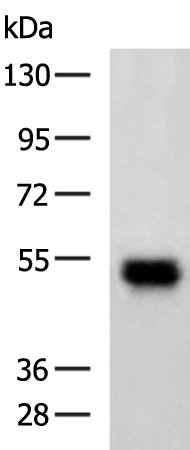
| WB | 咨询技术 | Human,Mouse,Rat |
| IF | 咨询技术 | Human,Mouse,Rat |
| IHC | 咨询技术 | Human,Mouse,Rat |
| ICC | 技术咨询 | Human,Mouse,Rat |
| FCM | 咨询技术 | Human,Mouse,Rat |
| Elisa | 1/5000-1/10000 | Human,Mouse,Rat |
| Aliases | TAU; MSTD; PPND; DDPAC; MAPTL; MTBT1; MTBT2; tau-40; FTDP-17; PPP1R103 |
| WB Predicted band size | 79 kDa |
| Host/Isotype | Rabbit IgG |
| Antibody Type | Primary antibody |
| Storage | Store at 4°C short term. Aliquot and store at -20°C long term. Avoid freeze/thaw cycles. |
| Species Reactivity | Human, Mouse, Rat |
| Immunogen | Fusion protein of human MAPT |
| Formulation | Purified antibody in PBS with 0.05% sodium azide and 50% glycerol. |
+ +
以下是关于MAPT(tau蛋白)抗体的3篇参考文献,包含文献名称、作者及摘要概括:
---
1. **文献名称**:*"Phosphorylation-specific antibodies for tau protein in Alzheimer's disease"*
**作者**:Hasegawa, M., et al.
**摘要**:该研究开发了针对不同磷酸化位点的tau蛋白特异性抗体,用于检测阿尔茨海默病患者脑组织中的异常tau聚集。结果表明,这些抗体能有效区分病理性与正常tau,为神经退行性疾病的诊断提供了工具。
---
2. **文献名称**:*"Anti-tau antibodies targeting pathogenic forms inhibit tau propagation in a mouse model"*
**作者**:Yanamandra, K., et al.
**摘要**:研究探讨了单克隆tau抗体在转基因小鼠模型中对病理性tau传播的抑制作用。结果显示,特定抗体可减少tau蛋白的细胞间传递,并改善神经功能,支持其在tau病变治疗中的潜力。
---
3. **文献名称**:*"Tau antibody therapies: lessons from preclinical and clinical trials"*
**作者**:Sigurdsson, E.M., et al.
**摘要**:综述了tau靶向抗体在临床前及临床试验中的进展,分析了不同抗体设计(如靶向N端/C端、磷酸化表位)的疗效差异,并讨论了优化治疗策略的挑战与前景。
---
如需更多文献或补充细节,可进一步指定研究方向(如诊断、治疗或机制)以缩小范围。
MAPT (microtubule-associated protein tau) antibodies are essential tools in neuroscience research, particularly for studying tauopathies—a group of neurodegenerative disorders including Alzheimer’s disease, progressive supranuclear palsy, and frontotemporal dementia. The MAPT gene encodes tau, a protein predominantly expressed in neurons, where it stabilizes microtubules and supports axonal transport. Pathologically, hyperphosphorylation, aggregation, or mutations in tau lead to neurofibrillary tangles, a hallmark of tauopathies.
MAPT antibodies target specific epitopes or post-translational modifications of tau, enabling researchers to distinguish between physiological and pathological forms. Commonly used antibodies recognize phosphorylation sites (e.g., AT8. AT100), aggregation-prone regions, or isoforms generated by alternative splicing (e.g., 3R/4R tau). These antibodies are employed in techniques like immunohistochemistry, Western blotting, and ELISA to assess tau distribution, modification, and aggregation in cellular models, animal studies, and human tissues.
Clinically, MAPT antibodies aid in diagnosing tauopathies by detecting pathological tau in cerebrospinal fluid or via imaging probes. They also underpin therapeutic development, including tau-targeted immunotherapies. However, challenges remain in ensuring antibody specificity, as tau exhibits structural diversity and shared epitopes with other proteins. Ongoing research focuses on refining antibody designs to improve diagnostic accuracy and therapeutic efficacy in combating tau-driven neurodegeneration.
×